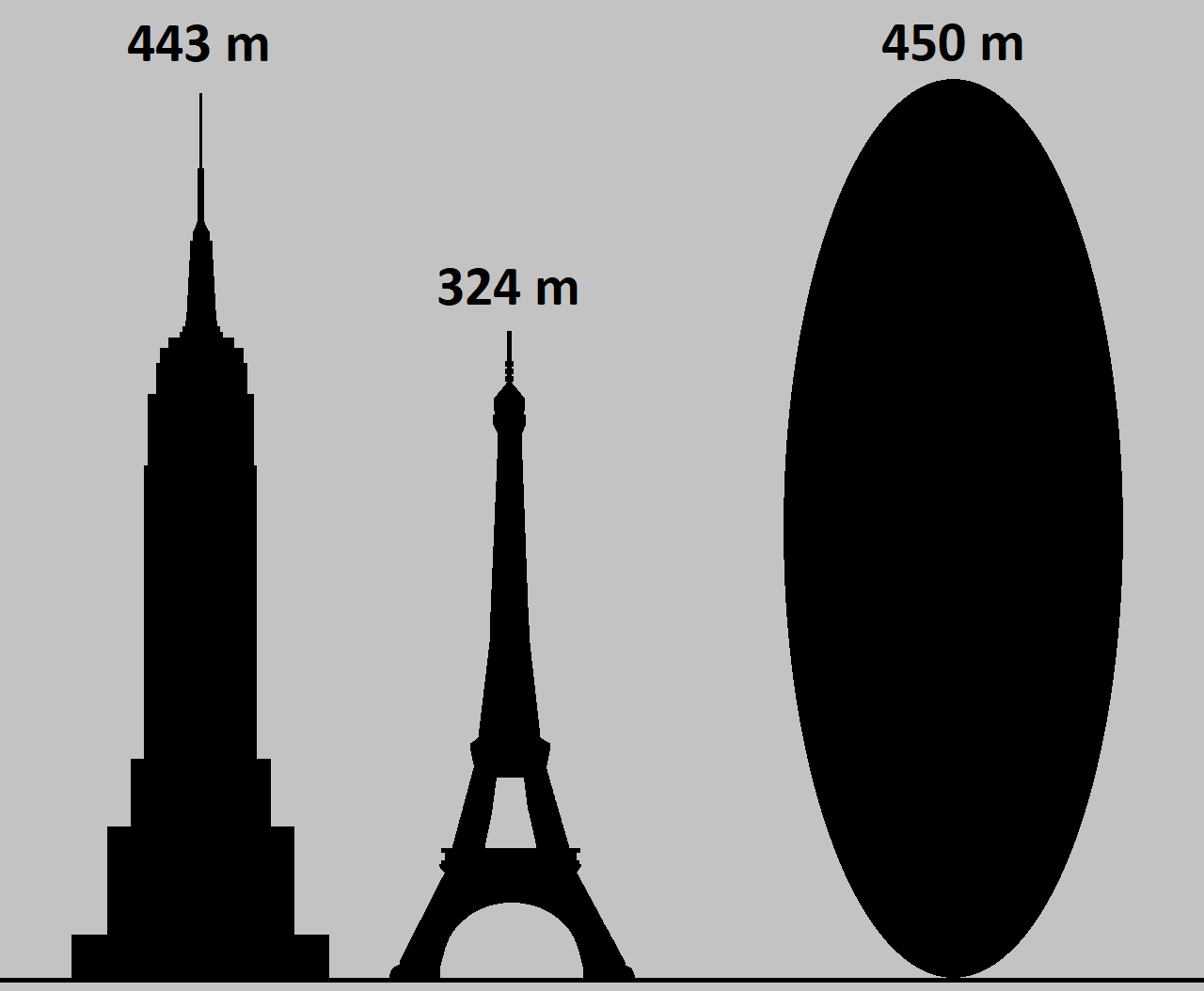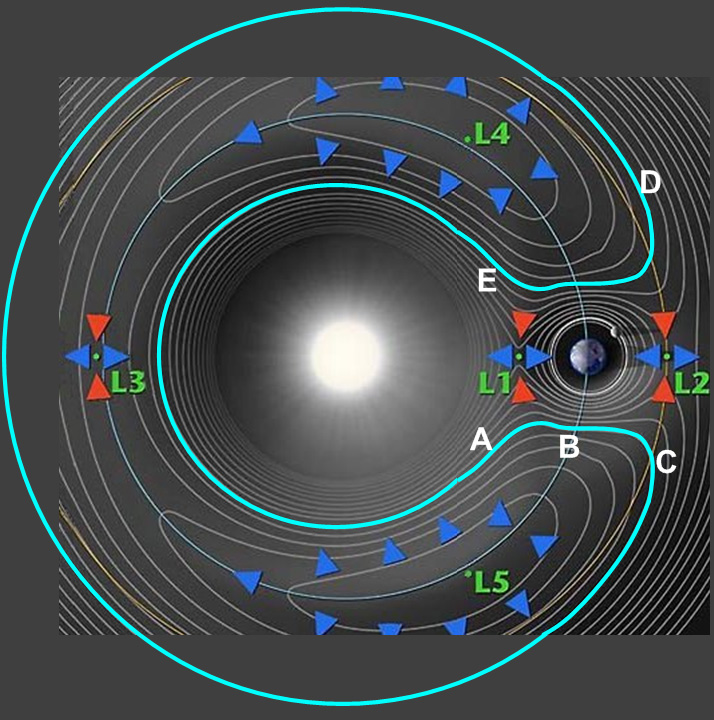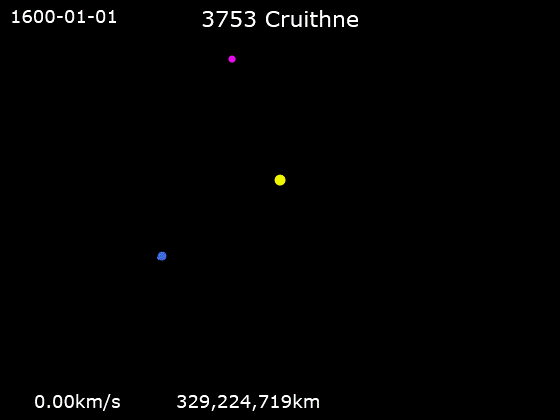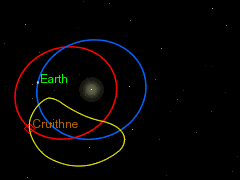As I was producing a PDF of my presentation from last month’s meeting, I realized that the members had so many good questions that it would be easier to understand if I split it into several articles so I can expand the answers to those questions. It’s taken quite a while to produce, but I hope you learn something! I welcome you to follow my links to sources and if it’s a Wikipedia article to follow their sources, too.
To answer one question that’s probably on your mind after reading the title, an occultation is one body blocking the view of another. In astronomy terms, it’s a mini-eclipse. In a future article, I’ll talk about Apophis occulting a star and the science data resulting from that event, but first, let’s look at the asteroid itself.
The presentation was on citizen science efforts to refine the orbit of the asteroid (99942) Apophis, which made the news for having the potential to hit Earth with devastating consequences. R. A. Tucker, D. J. Tholen, and F. Bernardi of Kitt Peak observatory discovered Apophis during the close pass June 19, 2004 and given the temporary name 2004 MN4. (2004 year of discovery, M=2nd half of June, N=13th object discovered) During its close approach with only a few observations that gave a rough estimate of the orbit, Apophis was given a 2.7% chance of impacting the Earth in 2029, which merited further study. Additional observations after the close pass reduce the 2029 pass impact to 0%, but later close passes were still shown to have potential for impacts.
By June 24, 2005, astronomers had a observed 2004MN4 enough for the International Astronomical Union to assign it the permanent number 99942. This change gave its discoverers the chance to name the asteroid and they settled on Apophis, after the Egyptian god of evil and destruction who dwelled in eternal darkness. Tholen and Tucker were reportedly fans of the TV show Stargate SG-1, where Apophis is an evil character bent on destroying Earth. Given that the observations gave Apophis repeated chances to hit Earth in the following decades and its size, Apophis an appropriate name! Officially, it is (99942) Apophis and informally as Apophis.
The initial Kitt Peak observations estimated Apophis to be 450 meters, based on its reflectivity. That’s roughly the height of the Empire State Building. The following year, the Infrared Telescope Facility revised the size downward to 350m. In 2012-2013, Arecibo radio telescope had a campaign to observe the asteroid to refine the orbit and size. After multiple observations, Arecibo refined the size to 450m x 170m:

Source: Wikipedia

Source: JPL/NASA

source: Science Direct through Wikipedia
Near Earth Objects

The outer orbit is Jupiter, so many PHAs cross the asteroid belt and may have originated there. Earth’s orbit is the white circle at center.
Source: Jet Propulsion Laboratory
Apophis is a Near Earth Object (NEO), which are objects that approach or cross Earth’s orbit around the Sun. NEO’s are broken into several categories by type:
- Near Earth Comets (NEC) – short period comets (200 year orbits or less) that return to Earth’s orbit
- Near Earth Asteroids (NEA) – asteroids like Apophis that come near Earth’s orbit
- Potentially Hazardous Asteroids (PHA) – NEAs that are larger than 140 meters (500 ft.) and closer to Earth than 0.05 AU and present a potential danger to Earth.
(AU = astronomical unit or the average Earth-Sun distance of roughly 93,000,000 miles.)
NEAs are further categorized based on their orbits. Each group is named after the first asteroid in the class:
- Amors – NEAs that orbit outside Earth’s orbit between 1.017 and 1.3 AU
- Apollos – Earth-crossing NEAs with semi-major axes larger than Earth’s orbit, so the asteroid spends most of its orbit outside Earth’s orbit.
- Atens – Earth-crossing NEAs with semi-major axes smaller than Earth’s orbit, so the asteroid spends most of its orbit inside Earth’s orbit.
- Atiras – NEAs that orbit inside Earth’s orbit and approach to

Aphelion = most distant point in orbit from the Sun
Semi-Major Axis = 1/2 the longest distance measured across the center of the orbit
Source Center for Near Earth Object Studies
There is one more odd class that fascinates me – These are called Co-Orbitals or asteroids that share Earth’s orbit, but have almost no chance to impact Earth:
- Trojans – Stable orbits in the L4 & L5 Lagrange points (60 degrees ahead and behind Earth)
- Most planets have at least a few Trojans
- The definition of a planet includes “has cleared the neighborhood around its orbit” and Trojan asteroids are a sign that this body is the dominant object in its orbit.
- Lagrange points are gravitationally stable points that form around a small body orbiting a larger body.

Source: Wikipedia
- Quasi-Satellites – eccentric orbits (elongated ellipses like comets) that synchronize with Earth.
- Earth’s gravity controls these asteroids so their orbit is in stable sync with Earth, so both circle the Sun in 365 days, but the satellite’s orbit is much more eccentric.
Source: Wikipedia
- Horseshoe Librators – Horseshoe-shaped orbits between L4 & L5 away from Earth.
- This is the strangest orbit I’ve ever seen and is hard to understand. Hopefully, the diagrams will help, but also check out the Wikipedia articles on Cruithne and Horseshoe orbits.
- Only a few horseshoe librators are known.
- The largest, 3753 Cruithne completes the horseshoe orbit every 770-780 years.

Source: Wikipedia

Source: Wikipedia

Source: Wikipedia
Apophis’ orbit
During the early observations, Apophis had a 1 in 256,000 chance to pass through a 600 meter-wide keyhole. If it hit that keyhole, the orbit would change and Apophis would hit the Earth in April 2036. After those calculations were made, astronomers began a campaign to observe Apophis and gain more accurate data on its orbit. With more accurate data, the probability of Apophis hitting the keyhole in 2029 was reduced to zero.
Apophis will still approach very closely to Earth and the 2029 encounter will alter its orbit so that it will change classification from an Aten to an Apollo NEA:

source: JPL Small-Body Database Browser (nasa.gov)
The approach is quite close, actually within the orbits of some geostationary satellites, but well above the crowded low-Earth orbit where a vast majority of our satellites reside:
The first is in relation to the Moon’s orbit.
The second shows Apophis’ orbital inclination as it passes Earth.
The last shows a white bar that represents the uncertainty of Apophis’ position
Source: Wikipedia
The 2029 pass will be visible in Europe, Africa, and Asia as a magnitude 3 (easy naked eye in suburban skies) object. It will be the closest pass by a large object ever recorded by man. Any pass within the Moon’s orbit is a near miss in astronomical terms and passing within the orbits of geosynchronous satellites is stunningly close.
I’ll close with saying that Apophis didn’t live up to the hype, but that is often the case with close approaching bodies. We regularly hear about small bodies discovered just before or just after they pass close to Earth. Nearly all have no chance of hitting Earth and few are large enough to cause real damage on Earth. In my next article, I’ll take a closer looker how scientists rate the danger and what we plan to do about PHAs if we have the chance.
Links
- Apophis listing Small Body Database https://ssd.jpl.nasa.gov/sbdb.cgi?sstr=apophis
- Center for NEO Studies (CNEOS) https://cneos.jpl.nasa.gov/
- Asteroid classification CNEOS https://cneos.jpl.nasa.gov/about/neo_groups.html
- IAU planet definition https://www.iau.org/news/pressreleases/detail/iau0603/
- Wikipedia on Apophis https://en.wikipedia.org/wiki/99942_Apophis (See the references and diagrams)








More Stories
Trends and Friends Segment!
March 16 Ransom Canyon Star Party Canceled
Eclipse 101 For Hosts and Teachers